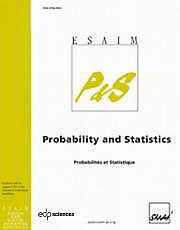Article contents
A graph-based estimator of the number of clusters
Published online by Cambridge University Press: 19 June 2007
Abstract
Assessing the number of clusters of a statistical population is one of the essential issues of unsupervised learning. Given n independent observations X1,...,Xn drawn from an unknown multivariate probability density f, we propose a new approach to estimate the number of connected components, or clusters, of the t-level set $\mathcal L(t)=\{x:f(x) \geq t\}$  . The basic idea is to form a rough skeleton of the set $\mathcal L(t)$
. The basic idea is to form a rough skeleton of the set $\mathcal L(t)$  using any preliminary estimator of f, and to count the number of connected components of the resulting graph. Under mild analytic conditions on f, and using tools from differential geometry, we establish the consistency of our method.
using any preliminary estimator of f, and to count the number of connected components of the resulting graph. Under mild analytic conditions on f, and using tools from differential geometry, we establish the consistency of our method.
Information
- Type
- Research Article
- Information
- Copyright
- © EDP Sciences, SMAI, 2007
References
G.E. Bredon, Topology and Geometry, Springer-Verlag, New York, Graduate Texts in Mathematics 139 (1993).
Brito, M.R., Chavez, E.L., Quiroz, A.J. and Yukich, J.E., Connectivity of the mutual k-nearest neighbor graph in clustering and outlier detection.
Statist. Probab. Lett.
35 (1997) 33–42.
CrossRef
Cadre, B., Kernel estimation of density level sets.
J. Multivariate Anal.
97 (2006) 999–1023.
CrossRef
I. Chavel, Riemannian Geometry: A Modern Introduction. Cambridge University Press, Cambridge (1993).
T.H. Cormen, C.E. Leiserson and R.L. Rivest, Introduction to Algorithms. The MIT Press, Cambridge (1990).
Cuevas, A., Febrero, M. and Fraiman, R., Estimating the number of clusters.
Canad. J. Statist.
28 (2000) 367–382.
CrossRef
Cuevas, A., Febrero, M. and Fraiman, R., Cluster analysis: a further approach based on density estimation.
Comput. Statist. Data Anal.
36 (2001) 441–459.
CrossRef
Devroye, L. and Wise, G., Detection of abnormal behavior via nonparametric estimation of the support.
SIAM J. Appl. Math.
38 (1980) 480–488.
CrossRef
R.O. Duda, P.E. Hart and D.G. Stork, Pattern Classification, 2nd edition. Wiley-Interscience, New York (2000).
L. Györfi, M. Kohler, A. Krzyżak and H. Walk, A Distribution-Free Theory of Nonparametric Regression. Springer-Verlag, New York (2002).
J.A. Hartigan, Clustering Algorithms. John Wiley, New York (1975).
T. Hastie, R. Tibshirani and J. Friedman, The Elements of Statistical Learning: Data Mining, Inference, and Prediction. Springer, New York (2001).
S. Kobayashi and K. Nomizu, Foundations of Differential Geometry, Vol. I & II, 2nd edition. Wiley, New York (1996).
U. von Luxburg and S. Ben-David, Towards a statistical theory of clustering. PASCAL Workshop on Statistics and Optimization of Clustering (2005).
Penrose, M.D., A strong law for the longest edge of the minimal spanning tree.
Ann. Probab.
27 (1999) 246–260.
Polonik, A., Measuring mass concentrations and estimating density contour clusters–an excess mass approach.
Ann. Statist.
23 (1995) 855–881.
CrossRef
B.L.S. Prakasa Rao, Nonparametric Functional Estimation. Academic Press, Orlando (1983).
Tsybakov, A.B., On nonparametric estimation of density level sets.
Ann. Statist.
25 (1997) 948–969.
CrossRef
- 19
- Cited by

